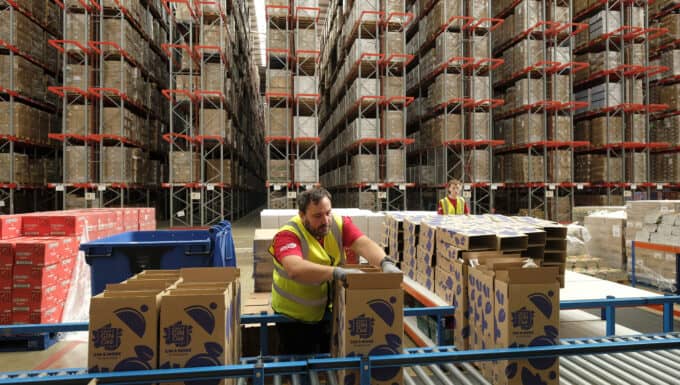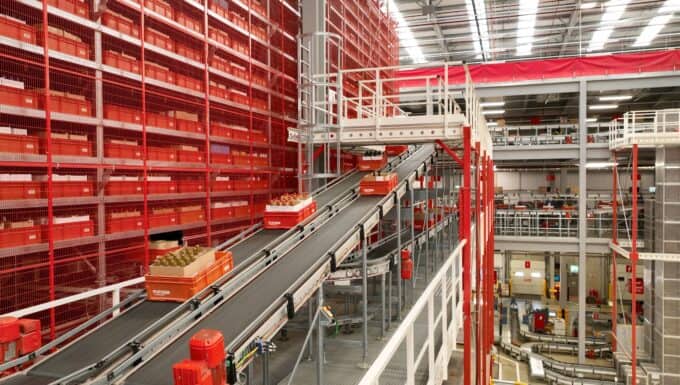In the fast-paced world of logistics, the efficiency of warehouse operations stands as a cornerstone of success. Yet, many businesses continue to grapple with the outdated warehouse practices, unaware of the significant toll it takes on their bottom line. From inventory inaccuracies to labour-intensive processes and inefficient space utilisation, the hidden costs of not deploying the most efficient operations can silently erode profitability and hinder business growth.
Imagine the scenario: orders delayed due to misplaced inventory, exhausted employees struggling to keep up with demand, and valuable warehouse space underutilised. For logistics managers, CEOs, COOs, and CTOs, this is not a mere hypothetical; it’s the stark reality faced by countless businesses today. However, amidst these challenges lies a beacon of hope: the transformative power of ‘shared-user automation’. By recognising the pitfalls of inappropriate warehouse operations and embracing innovative solutions, businesses can unlock new levels of efficiency, productivity, and profitability.
In this blog article, we delve into the heart of the matter, shedding light on three critical areas where not using the appropriate warehouse operations could be costing you dearly. From the shadows of inefficiency, we emerge armed with insights and solutions, poised to guide companies towards a brighter automated future. Join us as we explore the path to warehouse optimisation and discover the key to unlocking untapped potential in your operations.
Inventory inaccuracy
Inventory inaccuracies inherent in some manual warehouse management can pose a real threat to operational efficiency. Through the manual handling of inventory, errors such as data entry mistakes, misplacements, and shrinkage often creep in unnoticed. These inaccuracies manifest in tangible disruptions to the order fulfilment process, resulting in delays, stockouts, and unnecessary carrying costs for excess inventory.
To combat the scourge of inventory inaccuracies, businesses must embrace technological advancements. Implementing barcode or RFID technology offers a robust solution for accurate inventory tracking, providing real-time visibility into stock levels and locations. However, despite the upfront costs of automation falling in recent years according to an article in the Financial Times, it’s still a huge capital investment for any size of business to make as often they’re asked to sign up to lengthy, costly contracts with 3PL providers to access that type of solution. Alternatively, businesses who don’t have the resource or desire to do that face upsetting their own status quo in peak: the extra demand and volatility could easily lead to costly mispicks, delays to dispatch and higher return rates.
A potential solution to the difficulties felt over busier periods for smaller retailers is to make use of automation. Automated systems can also handle inventory management, helping to minimise dispatch delays and alleviating the strain on customer services. Such systems can feel out of reach for businesses with a smaller budget, but Europa Warehouse – the award-winning, specialist third-party logistics (3PL) division of Europa Worldwide Group – has a ‘shared-user’ automated warehouse. This single facility provides state-of-the-art, £11 million automation technology to multiple businesses, making access more affordable. Such a system is almost unique to the UK market.
The adoption of inventory management software equipped with automated replenishment features improves order fulfilment efficiency. Furthermore, conducting regular cycle counts and audits serves as a proactive measure to maintain inventory accuracy, enabling businesses to identify and rectify discrepancies swiftly. In the relentless pursuit of operational excellence, businesses can fortify their operations against the disruptive effects of manual inventory management, paving the way for enhanced efficiency and sustained growth.
Labour intensity and shortages
The heart of any warehouse beats to the rhythm of its workforce, but in today’s economy the strains of manual labour are casting a shadow over productivity and profitability. From the moment goods arrive to the final dispatch, manual operations demand significant human effort. Picking, packing, and shipping tasks form the backbone of warehouse operations, yet their manual execution often leads to inefficiencies and challenges.
The impact on productivity is profound, with increased labour costs and prolonged processing times becoming all too familiar.
However, the path to liberation from labour issues lies in finding the best blend between human input and innovative management systems in an efficient and cost-effective manner. Companies in need of warehouses services need to embrace robotic picking systems, and conveyor systems to alleviate the strain on human resources when it becomes a bottleneck while streamlining workflow processes and experience a seismic shift towards efficiency and precision.
Meanwhile, the implementation of warehouse management systems (WMS) offers a lifeline, facilitating optimised task allocation and tracking to maximise productivity. These solutions pave the way for a harmonious convergence of human resource management and technological prowess, empowering companies to thrive amidst the evolving demands of modern logistics.
As reported by the Chartered Institute of Purchasing and Supply (CIPS), the logistics sector is predicted to face a massive 40,0000 workforce shortfall by 2026 if action is not taken. Businesses must work hard by building a culture within organisations that embraces change and demonstrates to its team that they are an important and indispensable part of the next generation of logistics.
Although the logistics market continues to face external challenges, companies like Europa are gaining market share and solidifying their financial position as one of the fast growing, exciting and successful operators in the industry. This however cannot be achieved without the right values, vision and HR strategies that help to create an engaged and happy team.
Limited scalability and growth opportunities
In the realm of manual warehouse operations, the spectre of limited scalability looms large, casting a shadow over aspirations of business growth. As operations expand, the limitations of manual workflows become increasingly evident, hindering the seamless adaptation required for sustained success. There is an urgent need to create greener and more optimised environments in every sense, so all strategic decisions must factor in cost, as well as efficiency, across the entire construction and operational lifecycle of a warehouse. Everyone understands the importance that sustainable warehouses need to play to satisfy stakeholders, improve the bottom line and prioritise the planet. Every warehousing strategy should be underpinned by this ethos.
Scaling manual operations presents a formidable challenge, fraught with complexities and pitfalls. With growth comes heightened intricacies, amplifying the risk of errors and operational inefficiencies. The burden of manual labour intensifies, stretching resources thin and leaving little room for manoeuvre amidst mounting pressures. In this landscape, the status quo becomes a barrier to progress, stifling innovation and impeding the realisation of ambitious goals.
Yet, amidst the shadows of constraint, beams of opportunity emerge, illuminating the path towards scalability and prosperity. Strategic planning becomes paramount, guiding future growth initiatives with a keen eye on automation and technology investments that promise to catalyse expansion and drive competitive advantage.
In 2023, Europa’s portfolio of warehouses picked 78.8 million units through its automated and manual fulfilment operations – regularly scaling up to 280,000 individual picks in a 24-hour period. Shared-user automation contributed towards this, allowing for regular scaling from 40 to 100,000 picks from one day to the next. The ability to scale in this way within automation is what makes it such a cost-effective solution. The ability to scale in a similar way in a manual environment is far more complex, requiring significantly more labour at a time of year when labour is at a premium. In the automated environment, those headaches simply don’t exist.
Conclusion
As we draw the curtains on our exploration of manual warehouse operations, it’s crucial to reflect on the profound impact these practices can have on efficiency, productivity, and profitability. From inventory inaccuracies to labour intensity and limited scalability, the pitfalls of manual operations cast a shadow over businesses striving for operational excellence. The repercussions of these challenges ripple through the fabric of warehouse management, disrupting workflows and hindering growth opportunities.
The journey towards warehouse optimisation begins with a willingness to evaluate the suitability of manual operations and embrace the possibilities offered by automation. Let us embark on this transformative journey together, driven by a shared vision of efficiency, productivity, and profitability. The time for action is now. You can speak with our team of expert today.


























